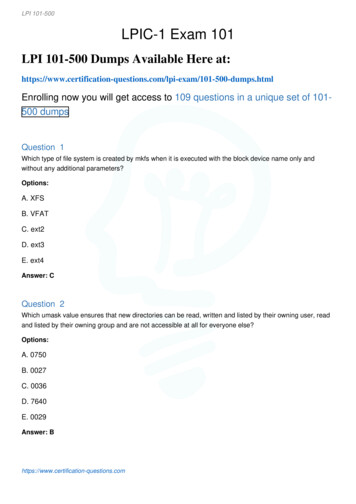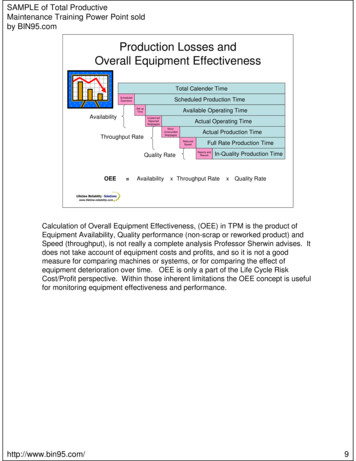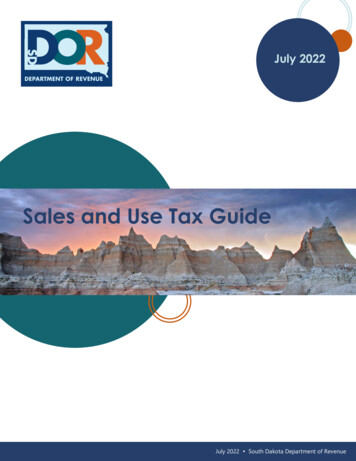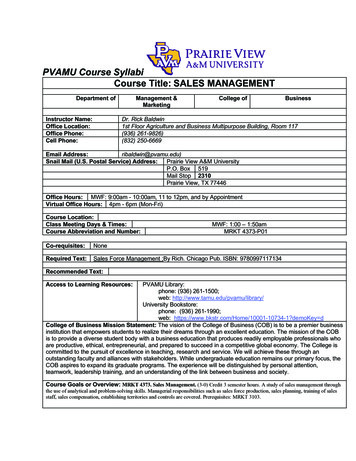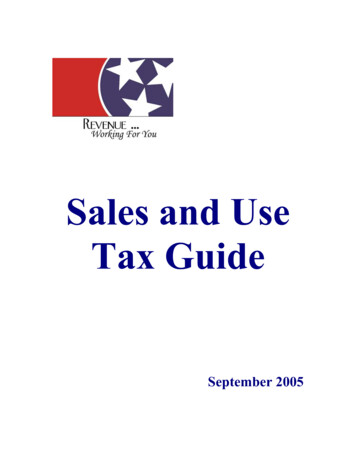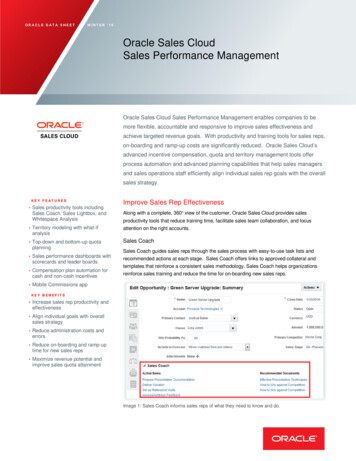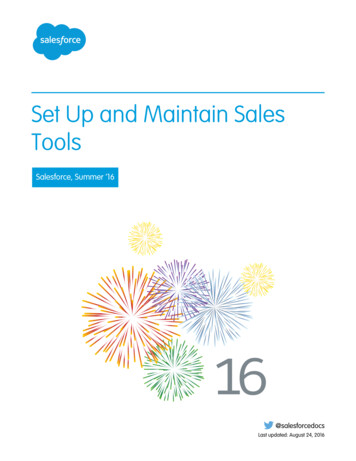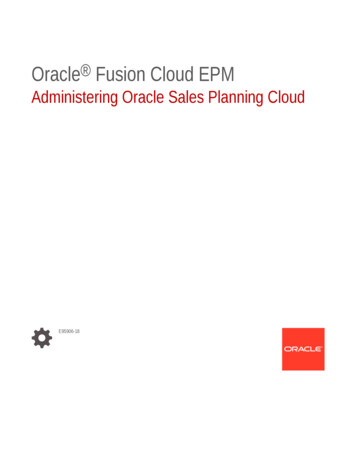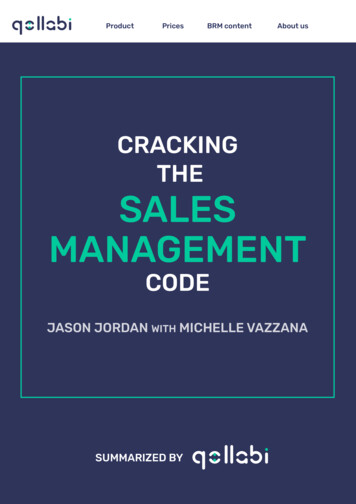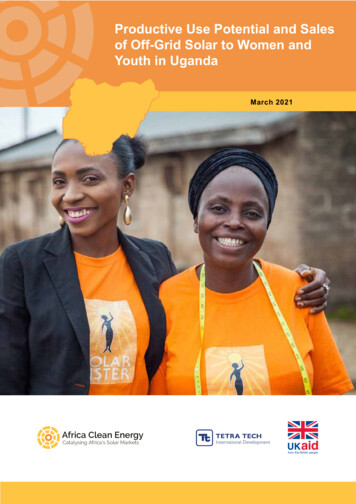
Transcription
Productive Use Potential and Salesof Off-Grid Solar to Women andYouth in UgandaMarch 2021Africa Clean EnergyCatalysing Africa’s Solar Markets
Foreign, Commonwealth and Development Office (FCDO)Africa Clean Energy Technical Assistance FacilityMarch 2021Tetra Tech International DevelopmentProsperity House, Westlands Road,P.O. Box 4320, 00100, Nairobi, Kenya.Tel: 254 (0)20 271 0485Cover Image Copyright Patrick Bentley [CC BY 2.0 (https://creativecommons.org/licenses/by/2.0)]The Africa Clean Energy Technical Assistance Facility (ACE TAF) is indebted to the United Kingdom’s Foreign,Commonwealth and Development Office (FCDO) through Tetra Tech International for its technical and financialsupport towards this study.ACE TAF extends its warm appreciation to the respondents who took valuable time from their busy schedules toparticipate in the key informant interviews and the online survey. Respondents represented a wide range of playersfrom the Ugandan off-grid solar (OGS) sector including private sector companies, women, youth and persons livingwith disabilities (PLWD) associations, academia, farmer groups, development partners and government agencies.ACE TAF also appreciates the leadership of Joel Essien, ACE TAF Country Manager, Uganda; Isaiah Oonyu,Assistant Country Manager; Wanjiku Ngunjiri, ACE TAF Gender and Social Inclusion Advisor; Christine Butegwa,Senior National Gender Consultant; and Dr Mumbi Machera, Gender and Social Inclusion Advisor in compilingthe findings for this report.2 Women in Solar Energy: Managerial, Operational and Artisanal
TABLE OF CONTENTSACKNOWLEDGEMENTS2ABBREVIATIONS AND ACRONYMS4EXECUTIVE SUMMARY5CHAPTER 1: CONTEXT AND RATIONALE FOR THE STUDY891.1 Study Objectives and MethodologyCHAPTER 2: STUDY RESULTS112.1 Socio-economic Context for Women, Youth and PLWD in Uganda112.2 Legal and Policy Frameworks: Gender Equality and Social Inclusion in Uganda122.3 Legal and Policy Frameworks for Renewable Energy and OGS Sector16CHAPTER 3: EVIDENCE FROM DATA TRIANGULATION OF PRIMARY AND SECONDARYDATA183.1 Productive Use of Off-Grid Solar in Uganda183.2 Level of Awareness on Available PUE Opportunities for Women, Youth and PLWD183.3 Access, Affordability and Uptake of OGS for Productive Use193.4 Affordability: The Ability to Pay203.5 Uptake of OGS for Productive Use by Women, Youth and PLWD2123CHAPTER 4: OPPORTUNITIES FOR PARTICIPATION OF WOMEN, YOUTH AND PLWD IN OGSPUE4.1 Barriers to PUE Uptake Among Women, Youth and PLWD234.2 Lack of Decision-Making Power Over OGS Resources by Women, Youth and PLWD24CHAPTER 5: RECOMMENDATIONS TO ADDRESS GESI GAPS IN THE OGS FOR PUE26CHAPTER 6: LESSONS LEARNT IN PROMOTING PUE UPTAKE BY WOMEN, YOUTH ANDPLWD IN UGANDA30REFERENCES31ANNEXESAnnex 1: Explicit Gender and Social Inclusive Projects in OGS Uptake for Productive Use32(Source: UOMA, 2018)Annex 2: List of Key Informants and Contacts Women in Solar Energy: Managerial, Operational and Artisanal323
ABBREVIATIONSACE TAFFCDOGDPGESIGIZGoUGSADDMEMDMWNDP SMEsUNCDFUPHCUSEAVSLAsWTP4Africa Clean Energy Technical Assistance FacilityForeign, Commonwealth and Development OfficeGross Domestic ProductGender Equality and Social InclusionGerman Corporation for International CooperationGovernment of UgandaGender, sex and age disaggregated (data) energy statisticsMinistry of Energy and Mineral DevelopmentMega WattsThird National Development PlanNational Union of Coffee Agribusinesses and Farm EnterprisesNational Union of Women with Disabilities in UgandaOff-Grid SolarPay-As-You-GoProductive use of energyPersons with disabilitiesRural Electrification AuthorityRenewable Energy Civil Society OrganisationsSavings and Credit Cooperative SocietiesStand Alone SolarSolar Home SystemSmall and Medium EnterprisesUnited Nations Capital Development FundUganda Population and Housing CensusUganda Solar Energy AssociationVillage Savings and Loans AssociationsWillingness To Pay Women in Solar Energy: Managerial, Operational and Artisanal
EXECUTIVE SUMMARYIntroductionWomen make up 51 per cent of Uganda’s population and the country has one of the youngestpopulations in the world, with young people making up more than 50 per cent of the total population.1Forty-four per cent of households in the country have a family member with a disability, 12 per cent ofwho have someone with a severe disability. Persons living with disabilities (PLWD) also make up about10 per cent of the working population.2 Studies have shown that failure to address gender equalityand disability in national programmes can have a detrimental effect on development, including energyprogrammes. For instance, loses in productivity due to ineffectively addressing disability range from 1per cent to 7 per cent of GDP.2 Therefore, exploring and addressing GESI in productive use of OGSwill contribute to improving livelihoods, increasing incomes and overall poverty reduction, especially forwomen, youth and PLWD.Study ObjectiveThe main objective of this study was to establish the uptake of and identify opportunities for the use ofstand-alone solar (SAS) products for productive use of energy (PUE), specifically by women, youth andPLWD in Uganda.We also sought to establish whether SAS products are affordable and accessible to women, youthand PLWD and identify how gender disparities affect women’s and men’s control over PUE products.In addition, the study endeavoured to gauge the levels of awareness, barriers as well as existingopportunities for women, youth and PLWD towards uptake of SAS products for PUE. This study soughtto establish whether there is sex-disaggregated data on access, affordability and uptake of SASproducts for PUE in UgandaProductive use of energy (PUE), is described as the use of energy for income generationin formal and informal enterprise, which can be home-based or in an enterprise location,including farm and non-farm income generation. Therefore, exploring and addressingGESI benefits in the context of OGS PUE will lead to recommendations on how tocontribute to improving livelihoods, increasing incomes and overall poverty reduction,especially for women, youth and PLWDMethodologyThe study used a mixed methods approach to obtain and triangulate data. A comprehensive literaturereview was undertaken, with key documents obtained from ACE TAF, energy research institutions andrelevant public domains. Additionally, key informant interviews were conducted with 23 respondentsrepresenting private sector solar companies, women, youth, PLWD and their associations, academia,farmer groups, development partners and government agencies. A survey was conducted online withover 200 respondents mainly through solar and farmer groups.Findings and recommendationsOverall, the study reveals that the level of awareness of OGS is quite high in Uganda. Respondentsindicated that they learnt about SAS products through marketing departments of solar companies thatplace adverts on radio and other media outlets. Awareness of SAS products is higher in urban areasthan in rural areas. This is likely a result of the fact that urban residents have access to more informationon OGS through a variety of channels including TV, newspapers and social media.1. Uganda Household Survey, 2016/2017.2. Government of Uganda (2019). State of Uganda Population Report – Promote social protection: Ensure equity and equality in harnessing the demographicdividend.3. ibid. Women in Solar Energy: Managerial, Operational and Artisanal5
The use of SAS products in Uganda can be categorised into micro- and meso-level use. At the microlevel, households are using solar home systems (SHS) mainly to substitute lighting from the grid. It isalso apparent that most PLWD are using solar for lighting in their homes but less for businesses. At themeso-level, some agricultural processors such as the National Union of Coffee Agribusiness and FarmEnterprises (NUCAFE), who are promoting the production of eco-friendly coffee, have installed solarpanels in their coffee production facilities. Such initiatives anticipate the generation of large amountsof OGS with the aim of selling any excess to the government. There is, however, limited awareness ofPUE among PLWD, including by their associations.The study also reveals a set of barriers and opportunities facing women, youth and PLWD in the uptakeof PUE. The types of enterprises owned by women and youth are both an opportunity and barrierfor OGS PUE. The study found that women dominate the service sectors, in particular food vending,which consumes low levels of energy. On the other hand, men dominate the agriculture, fisheries andmanufacturing sectors which are heavy energy consumers.4Electricity use was associated with better outcomes for businesses, which were mainly male businesses.Female enterprises were associated with lower profits and lower electricity consumption Conversely,evidence shows that if energy companies target specific enterprises where women are employed, forexample training women in food preparation or food vending sectors, and processing (e.g. diary andfish processing), PUE in these enterprises can increase.5 Youth in Uganda are mainly found in microand small-scale enterprises such as carpentry, barber shops, phone charging and small grocery shopswith cold storage facilities.The agricultural processing sector presents a big opportunity for PUE uptake by women, youth andPLWD. Currently, some aspects of the coffee and dairy value chain use SAS for agro-processing andvalue addition, including milling, husking and drying. The horticultural sector, where many women andyouth are employed, has also started using SAS for irrigation and drying. There are opportunities forother agricultural value chains, such as tea, to make use of OGS PUE.Differences in access to credit, finance and capital between women-owned enterprises and maleowned enterprises affects how their businesses can invest in SAS appliances and technologies, suchas fridges, water pumps and power tools.The study provides the following key recommendations to improve the uptake of PUE by women, youthand PLWD:GovernmentImprove multi-sectoral coordination: There needs to be more engagement between the Ministryof Energy and Mineral Development (MEMD) and other ministries to support the integration ofGESI in the energy sector and OGS for productive use in particular.Prioritise resource allocation through institutionalised gender budgeting guidelines andpromoting disability inclusion budgets to ensure that GESI is mainstreamed and functionallyimplemented.Build the capacities of individuals responsible for GESI mainstreaming in the OGS sector (e.g.gender focal persons) in the different ministries, including MEMD, to improve implementation ofcurrent policies and to ensure planned policies are developed and adopted.4. UPHS, 20145. IDS and GIZ (2019). Unlocking the benefits of productive use of energy for women in Ghana, Tanzania and Myanmar.6 Women in Solar Energy: Managerial, Operational and Artisanal
Policy alignment and enforcement with a focus on PLWD, women and youth. Energy policiesand regulations all need to be aligned and enforced across the sectors and among all theplayers in the solar energy sector. This process has started with the inclusion of GESI in thedraft off-grid strategy.Strengthen gender, sex and age disaggregated data (GSADD) collection: There is need to collectbottom-up data from community level to national level in partnership with local governments.We propose that the GESI focal persons at ministries, departments and agencies (MDAs)should receive training in guiding and managing GSADD collection exercises.Private sectorImprove GSADD collection in OGS sector – OGS players and associations like Uganda SolarEnergy Association (USEA) and Centre for Research in Energy and Energy Conservation(CREEC) should be supported to carry out data collection and in-depth research on participationof women, youth and PLWD in OGS PUE and the value chain. Players from other sectorslike women’s associations, PLWD and youth associations can also be supported to conductOGS energy-focused studies of their members. USEA, for example, can identify the gapsand opportunities and then work with members to design programmes to address the gaps.Monitoring and evaluation, including collection of case studies and best practices, will go a longway in building the body of knowledge on women, youth and PLWD participation in productiveuse.Advocacy for OGS productive use – Collective advocacy for specific OGS policy and regulatoryframework that includes PUE and the value chain is important. USEA’s and Renewable EnergyCivil Society Organisations’ (RESCO) capacity in this area can be built through tailored trainings.Encourage development of gender-sensitive and disability inclusive company policies – Manysolar companies do not have explicit gender, youth or PLWD policies, plans or strategies.Companies can be supported to develop these through peer-to-peer learning as seen fromUnited Nations Capital Development Fund (UNCDF) or by partnering with organisations thatwork on these issues, such as disability organisations. The National Union of Women withDisabilities in Uganda (NUWODU), for example, supports organisations to conduct disabilityaudits and develop action plans to address gaps and challenges.Create/strengthen partnerships between OGS companies and women, youth, PLWD associations –For example, NUWODU is willing to create awareness on productive use of OGS to empower PLWD.Since NUWODU works with associations of women with disabilities in every district in Uganda, it is avaluable partner for OGS companies and players to promote productive use of OGS by PLWD, and isbest coordinated through USEA. NUCAFE and farmer groups like Igara Tea Growers, who have over6,000 members are also willing to partner with OGS companies to pilot and promote the participationof women, youth and PLWD in productive use of OGS. Currently, Igara Tea Growers farmers are onlyusing solar for lighting at home but not for productive use. Women in Solar Energy: Managerial, Operational and Artisanal7
1CONTEXT AND RATIONALE FOR THE STUDYWhile Sustainable Development Goal 5 recognises the importance of gender equality, and SustainableDevelopment Goal 7 has provided an ambitious target to ensure access to modern energy for all, to doublethe share of renewable energy in the global energy mix and to double the global rate of improvement inenergy efficiency, in reality energy access and gender equality have not been inextricably linked, andaddressing them together can offer social and economic development gains. The overwhelming realityis that it will not be possible to meet targets for affordable, reliable, sustainable, and modern energyaccess for all by 2030 unless the energy needs of women, youth and PLWD are met.This study investigates the potential for energy to be a vital resource for all persons and crucial for acountry’s development across various sectors like health, education, transport, agriculture, water, tradeand industrialisation. The country still has one of the lowest electricity access rates in Africa although6access rates have improved considerably from 5 per cent in 2002 to 28 per cent in 2019. Promotion ofrenewable energy, such as solar, is one of the government’s key strategies to improve electricity accessand meet its target of 80 per cent access by 2040.7 Currently, 28 per cent of rural residences rely onsolar lighting systems or solar lanterns, 3 per cent have solar home systems (SHS), while about 1 percent are connected to mini-grids. This illustrates the vast potential for renewable energy, particularlyOGS, in addressing the energy poverty in the country.Gender equality and social inclusion (GESI) is a process and strategy for ensuring the concernsof women and men from all social groups (ethnicity, disability, caste, age, geographic locations)are an integral dimension in the design, implementation, monitoring and evaluation of policiesand programmes in all spheres. With respect to the off-grid solar (OGS) energy sector, a GESIapproach would aim to promote equality and strengthen legitimacy by addressing existingdisparities and gaps highlighted in access and control over OGS resources, services, information,opportunities, distribution of power and decision making across the sector.8Women make up 51 per cent of Uganda’s population and the country has one of the youngestpopulations in the world, with young people making up more than 50 per cent of the total population.9Forty-four per cent of households in the country have a family member with a disability, with 12 per centhaving someone with a severe disability. Persons living with disabilities (PLWD) also make up about10 per cent of the working population.10 Studies have shown that failure to address gender equalityand disability in national programmes can have a detrimental effect on development, including energyprogrammes. For instance, loses in productivity due to ineffectively addressing disability range from 111per cent to 7 per cent of GDP. Therefore, exploring and addressing GESI in productive use of OGSwill contribute to improving livelihoods, increasing incomes and overall poverty reduction, especially forwomen, youth and PLWD.In Uganda, 31 per cent of households are female headed. Nonetheless, it is the women who are taskedwith management of the household throughout Uganda. In the poor and vulnerable communities, asignificant number of which are female headed, the bulk of household management usually involvessourcing fuel for cooking and lighting up the home. This reduces the productive time of the day forwomen. Kerosene has been the preferred fuel of choice for lighting since the 1980s, in no small partaided by government subsidies that have made it affordable, widely available and accessible in the ruralareas.6. Uganda Draft Energy Policy 2019.7. Uganda Vision 2040.8. Government of Nepal, Ministry of Science, Technology and Environment, Alternative Energy Promotion Centre (2014). Gender Equality and social inclusiontoolbox: Promotion for renewable energy technologies.9. Uganda Household Survey, 2016/2017.10. Government of Uganda (2019). State of Uganda Population Report – Promote social protection: Ensure equity and equality in harnessing the demographicdividend.11. ibid.8 Women in Solar Energy: Managerial, Operational and Artisanal
Female-headed households have the additional challenge of earning a livelihood while managing thehome. This underscores the need for greater attention towards women’s utilisation of energy resourcesfor income generation and productive use of energy (PUE). In addition, for greater empowerment,there is the need to now promote women’s role as energy agents and entrepreneurs and not just asconsumers. A detailed analysis of the PUE potential of OGS by women will reveal the opportunities fortime saving, income generation and improving the quality of life of women and their households.SHS have been increasingly available and acceptable throughout Uganda from the 2000s, acceleratedin part by the introduction of pay-as-you-go (PAYG) technology. While there is some data on generalsales of stand-alone solar (SAS) systems to women, there is limited information available on sales ofSAS systems for PUE purposes for youth and PLWD. The available data has only recently started beingdisaggregated, mainly due to donor and partner reporting requirements and aiming to capture the salesof solar to women, and then subsequently capturing the benefits of household solar for these groups.In 2018, the Government of Uganda (GoU) expressed interest to promote PUE as a strategy to increaseenergy access and enhance rural livelihoods, particularly through solar irrigation. Notably, approximately75 per cent of small-holder farmers in Uganda are women, and thus any enhanced uptake of solarirrigation is likely to positively impact rural farming households, and hence women’s incomes.While donor programmes and companies have highlighted sales of SAS to women as part of generalsales, an assessment of OGS productive use potential geared towards women and girls has not beendone in the Ugandan market. This study therefore assesses productive use potential of SAS through agender lens.1.1 Study Objectives and MethodologyThe main objective of this study is to establish the uptake of, and identify opportunities for, the useof SAS products for PUE, specifically by women, youth and PLWD in Uganda. PUE is described asthe use of energy for income generation in formal and informal enterprise, which can be home-basedor in an enterprise location, including farm and non-farm income generation.12 Therefore, exploringand addressing GESI in the context of productive use of OGS will contribute to improving livelihoods,increasing incomes and overall poverty reduction, especially for women, youth and PLWD.This study also sought to establish whether SAS products are affordable and accessible to women, theyouth and PLWD and identify how gender determines men’s and women’s control over PUE products.In addition, the study endeavoured to gauge the levels of awareness, barriers as well as existingopportunities for women, youth and PLWD towards uptake of SAS products for PUE. All in all, thisstudy sought to establish whether there is sex-disaggregated data on access, affordability and uptakeof SAS products for PUE in Uganda.The study used a mixed methods approach to obtain and triangulate data. A comprehensive literaturereview was undertaken, with key documents obtained from ACE TAF, energy research institutions andrelevant public domains. Additionally, key informant interviews were conducted with 23 respondentsrepresenting solar companies, women, youth, PLWD and their associations, academia, farmer groups,development partners and government agencies. A survey was also conducted online with over 200respondents mainly through solar and farmer groups.12. IDS & GIZ (2019). Unlocking the benefits of productive use of energy for women in Ghana, Tanzania and Myanmar. Women in Solar Energy: Managerial, Operational and Artisanal9
Two key limitations were identified. One, the study was conducted between December 2020 andFebruary 2021 amid the global COVID-19 pandemic. Measures to contain the spread of the virusprevented the organising of focus group discussions due to restricted physical interactions. Second, thestudy, which mainly adopted a qualitative approach relied on online surveys to collect quantitative data,which had a very low response rate due to, among others, the Internet shutdown during and after theelections in January 2021. There was persistent slow Internet connections a month after the electionswhich coincided with data collection and analysis for the study. High internet data costs also contributedto the low response rate for the online survey.10 Women in Solar Energy: Managerial, Operational and Artisanal
STUDY RESULTSEvidence was gathered from most recent sources of secondary data on OGS. The sources providedglobal, regional and national insights into the OGS value chain. The data and the insights weresynthesized to correspond to the key questions of this study.2.1 Socio-economic Context for Women, Youth and PLWD inUgandaAccording to the 2014 Uganda Population and Housing Census, females comprise 51 per cent of thepopulation of Uganda compared to 49 per cent of males. Socially, Uganda achieved the global targetof gender equality in primary school in the mid-2000s – the proportion of girls is higher than boys.However, due to barriers in retention of the girl-child, there are more boys than girls in higher levels ofeducation from secondary school to tertiary institutions. Therefore, generally, more men have higherlevels of education than women.ActivityMenWomenEngagement in paidemployment51%35%Family workUnpaid domestic and care work (collectingfirewood, fetching water, childcare)11%17% 15 hours 30 hoursSelf-employment38%48%Table 1: Comparison of men’s and women’s engagement in different economic activitiesThere are more women (48 per cent) engaged in self-employment activities than men (38 per cent).Women are more engaged in the trade (55 per cent) and manufacturing (51 per cent) sectors, whilethe transportation, construction, agricultural and fisheries sectors is dominated by men. Women tend tobe concentrated in service work (59 per cent) and elementary occupations (51 per cent) while men areconcentrated in plant/machine operations (95 per cent). 13PLWD make up 12.5 per cent of the Ugandan population, with children with disabilities (17 years oldand below) making up 2.9 per cent, youth with disabilities (18–30years) 2 per cent, adults living withdisabilities (31–64) 5.5 per cent, and older persons with disabilities (65 years and above) constituting2.1 per cent of the population. Disability is higher among women (6.9 per cent) compared to men (5.6per cent). In addition, the disability prevalence rate is higher among those living in the rural areas (10.3per cent) compared to those in the urban areas (2.2 per cent).14Poverty rates are high among PLWD due to the immense barriers they face in accessing social servicessuch as health, education and formal employment. PLWD are therefore majorly self-employed in theinformal sector in businesses such as tailoring, carpentry, shoe-shining and retail trade. PLWD are oftendeprived of productive resources such as land by their families. Women and girls with disabilities facedouble discrimination and are more vulnerable to violence, abuse and exploitation.1513. ibid.14. ibid.15. Uganda Equal Opportunities Commission (2017). Annual report on the state of equal opportunities in Uganda, FY 2016/17: Enhancing national developmentthrough equity and inclusion.Women in Solar Energy: Managerial, Operational and Artisanal 211
2.2 Legal and Policy Frameworks: Gender Equality and SocialInclusion in UgandaThe national legal and policy framework provides the mandate for government and other stakeholdersto promote gender equality and social inclusion in all sectors including the OGS sector. This sectionexamines the extent to which gender equality and social inclusion is taken into account.WomenChapter 4 of the 1995 Uganda Constitution calls for protection of human rights of all persons. TheConstitution prohibits discrimination and promotes affirmative action of marginalised groups includingwomen, PLWD and children.The 2007 Gender Policy is meant to guide and direct all levels of planning, resource allocation andimplementation of development programmes from a gender perspective. The priority areas for thepolicy are improved livelihoods, promotion and protection of rights, participation in decision-making andgovernance, recognition and promotion of gender in macro-economic management – all of which arerelevant in promoting women’s participation in OGS productive use.Whereas the Ministry of Gender, Labour and Social Development (MGLSD) is the line ministry leadingthe monitoring of the Gender Policy, all government ministries, departments, agencies and otherstakeholders have an equal responsibility in gender mainstreaming and implementation of the policyacross their programmes. The policy further outlines the roles of different stakeholders in implementingthe policy. In this regard, private sector players, such as solar companies, are required under the policy to,among other things: ensure that corporate policies and practices incorporate gender equality principles;ensure that essential products and services are accessible to both women and men, especially thepoor; provide incentives and support to women entrepreneurs; and institute and implement affirmativeaction measures.Affirmative action measures are a crucial internationally recognised strategy for promoting genderequality and social inclusion, particularly for historically marginalised groups such as women andPLWD. Affirmative action is legally enshrined in the Constitution and elaborated in numerous policiesand legal frameworks. According to the Gender Policy, public sector bodies and institutions such asMEMD, the ministries of Agriculture, Lands, Water and Local Government, and the Rural ElectrificationAgency (REA), are mandated to develop and implement sector specific gender policies, strategies andactivities; disaggregate data and information by sex and gender; commit adequate resources to genderrelated activities. Other policies that have integrated gender equality are summarized in Table 2.12 Women in Solar Energy: Managerial, Operational and Artisanal
Table 2: Polices integrating gender equalityPolicyRelevance to OGS and PUEEmployment Act 2006and EmploymentRegulations 2011Prohibits discrimination, promote women’s active participation in thelabour force and protect their labour rights, including maternity leave andprotection from sexual harassment at the workplace. Expectant mothersare protected from heavy or dangerous workload. The Act provides forequal pay for equal work for both women and men in the workforce.National AgriculturePolicy 2013Recognises gender equality as a guiding principle. It notes that“agricultural development services will be provided to all farmercategories as individuals or in groups, ensuring gender equity”.Government also commits to achieve equity by ensuring agriculturalinterventions are balanced across regions and between genders. Thepolicy promotes the use of appropriate, cost-effective technologies forprocessing agricultural commodities to enhance agricultural productivity.Education PolicyAddresses barriers to access and retention of girls at primary, secondaryand tertiary levels and provides for programmes to reach out-of-schoolyouth, including young women and girls. In addition, the Ministry ofEducation has put in place a Ministerial Directive permitting pregnantgirls to do examinations and further allocating them
6 Women in Solar Energy: Managerial, Operational and Artisanal The use of SAS products in Uganda can be categorised into micro- and meso-level use. At the micro- level, households are using solar home systems (SHS) mainly to substitute lighting from the grid.It is also apparent that most PLWD are using solar for lighting in their homes but less for businesses.
